January 4, 2019
Mackenzie Rey Navarro Volkmann was born in Manhattan, New York.
The second born of Kara Volkmann, my daughter, and her spouse, Mike Navarro. The sister of Adrian Michael Navarro Volkmann. My granddaughter.
Beautiful soul.


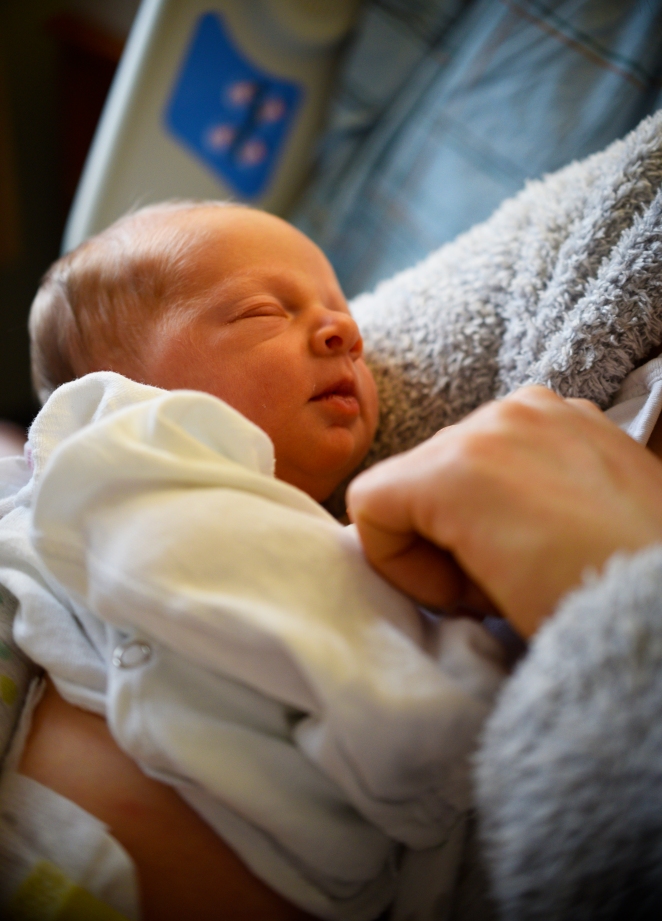







January 4, 2019
Mackenzie Rey Navarro Volkmann was born in Manhattan, New York.
The second born of Kara Volkmann, my daughter, and her spouse, Mike Navarro. The sister of Adrian Michael Navarro Volkmann. My granddaughter.
Beautiful soul.










Hedwig Dances curated this trip in collaboration with UK based Tailored Travel. Twelve intrepid travelers, led by the incomparable guide, Thomas Abbot, would explore Germany Sept 5 – 13. We began with three nights in Berlin, followed by three nights in Weimar and then we capped our adventure with two nights in Dessau where our final evening would include the unforgettable performance of FUTURA, Hedwig Dances’ Bauhuas-inspired contemporary dance, at the Bauhaus 100 Festival on the historical stage in the original Bauhaus building on which Oskar Schlemmer was staging his works a century ago. This album represents photos from our first evening in Berlin when we went to the historic Reichstag to see the incredible futuristic dome atop the parliament building as designed by William Foster of Foster and Partners. All photos in this album by Julie Volkmann. To learn more about the project’s design and manufacture, check out this site:https://www.fosterandpartners.com/…/reichstag-new-german-p…/
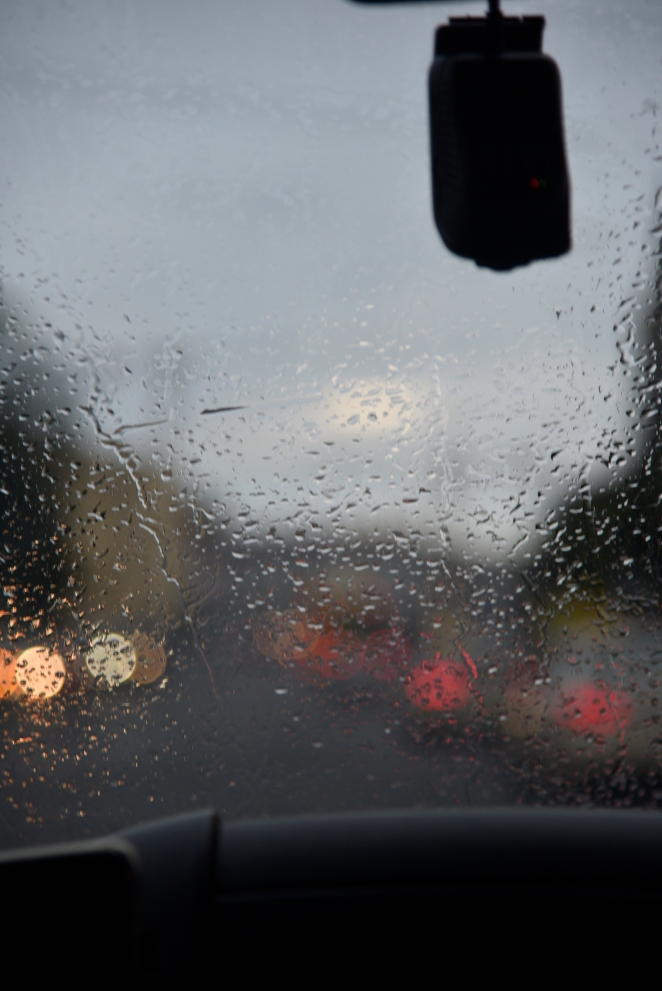
As we drove across town and Thomas spoke to us for the first, but not the last time, of the history of the architecture we were passing by. We worried that the rain would interfere with our enjoyment of our first night’s expedition to the Parliament building

and still the rain ushered us across Berlin toward the Reichstag and its famous dome.
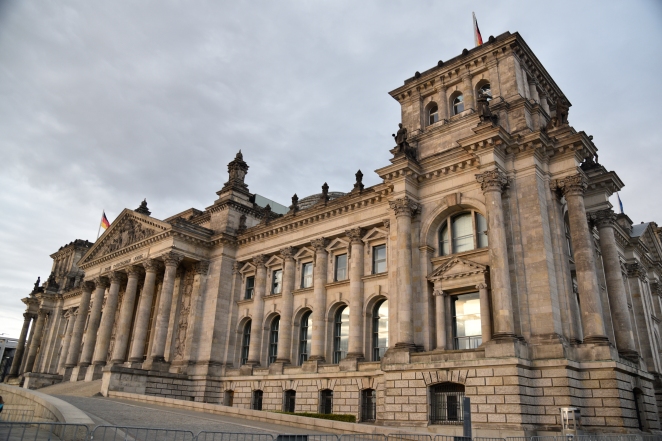
By the time we reached the impressive Reichstag, the rain had stopped and the skies presented us with spectacular light, cloud formations and beautiful reflections.

Britannica tells us “The Neo-Renaissance building was designed by Paul Wallot and was completed in 1894. It was the home of the Reichstag (“Imperial Diet”) from 1894 to 1933, during the periods of the German Empire (1871–1918) and the Weimar Republic (1919–33).”

Tho colors of the sunset sky and clouds reflected in the windows of the building created a spectacular glass canvas.
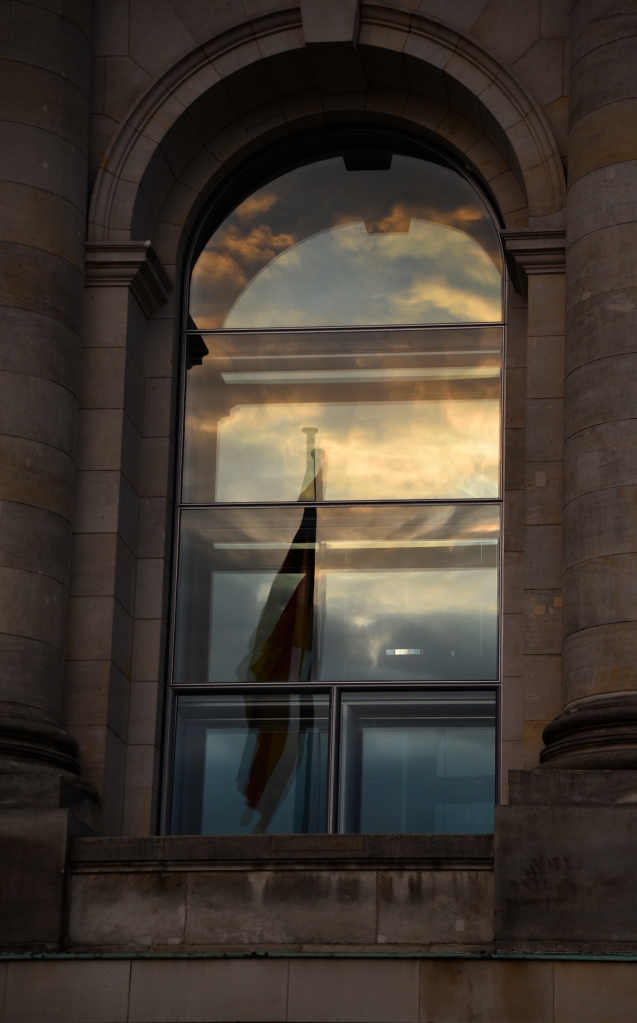
Though the previous shot said alot, this shot, with the German flag seemed an appropriate additional shot to speak the German people’s pride in their country.

An awesome approach, indeed.
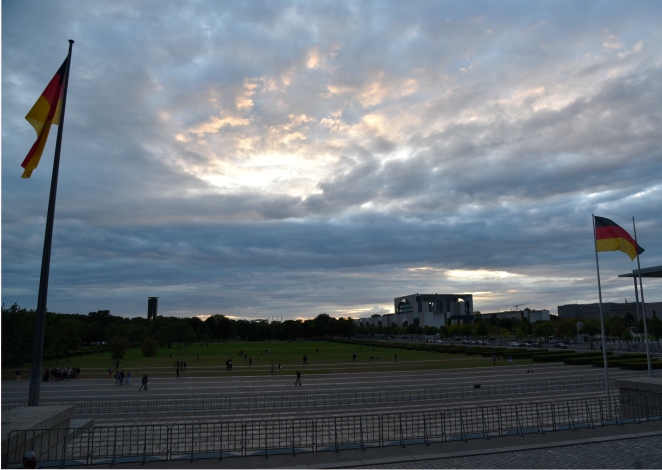
After climbing the steps and looking out onto the “front yard” of the Reichstag, I was taken by the power and beauty of the setting sun, perfectly framed by the clouds forming a circle around the center opening.
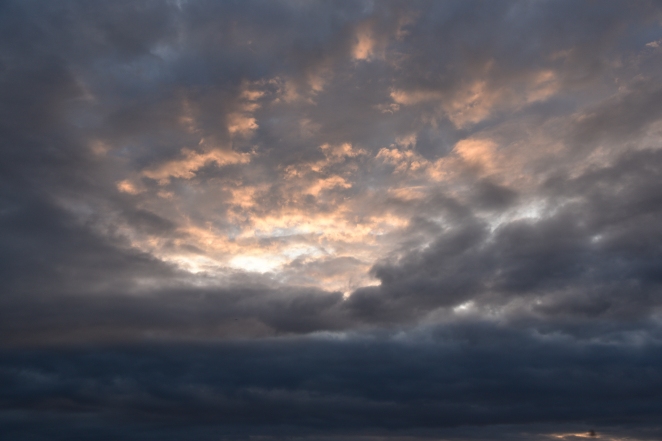
What a sight!

As we waited our turn to take the elevators to the top of the building, the sheer heights of the central area and the large works of art displayed on either side told us this was a space of great importance.

Though our encounter with the many powerful works of contemporary art displayed in the building was limited to this space, I found this documentary (link provided here) that speaks to the many works on display along with this introductory text: A film by Wolfgang Kabisch, 45min The Reichstag Building in Berlin was inaugurated as the new German parliament in April 1999. To mark the occasion nineteen artists were commissioned to create new works that directly refer to the building and its history. With other works either purchased or on loan, these artistic projects represent one of the most important collections of contemporary art in Germany. The film presents the artworks and their concepts and also shows how the artists came to conceive and finally install their works. Participating Artists: Georg Baselitz Joseph Beuys Christian Boltanski Grisha Bruskin Carlfriedrich Claus Lutz Dammbeck Hanne Darboven Rupprecht Geiger Gotthard Graubner Hans Haacke Bernhard Heisig Jenny Holzer Anselm Kiefer Markus Lüpertz Georg Karl Pfahler Sigmar Polke Gerhard Richter Ulrich Rückriem Katharina Sieverding Günther Uecker

I confess, I am a sucker for reflections – in glass, in water, in stone – wherever I see them.

Finally, after waiting for one of the large elevators that brought us to the rooftop, where we first saw and entered the dome.
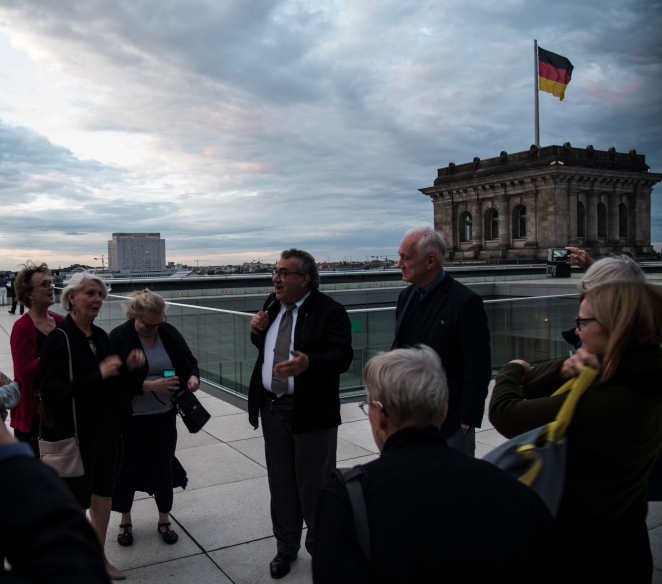
Once we were all on the roof, we listened to our guide, Thomas Abbot, as he spoke above the cold wind that whipped at us.
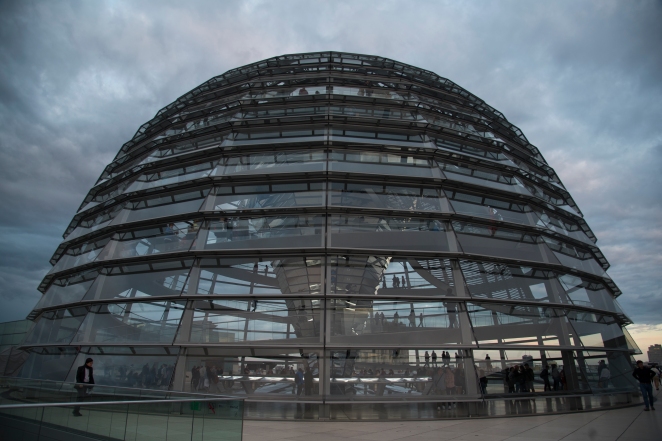
Our first full view of the dome as Thomas explained many things about its construction and significance to the Parliament building.

The juxtaposition of modern and historic.

Off in the distance is the Park Inn where the group stayed the first three nights. Just to the left and far below is the Spree river, on which my roommate Nancy and I travelled that very afternoon. Pictures of the sights from the river will be found in an earlier post.

After stepping inside the dome, the impressive staircase that spiraled up to the top of the dome beckoned to us to begin the ascent.

The central funnel is not merely a fascinating visual design of light, form, reflection and movement, it is integral to the heating and cooling of the entire building.

This piece travels with the sun to modulate heating and cooling forces in the building.

The same light modulating shape from another perspective.

Finally reaching the top of the circular walkway, we see the center of the dome’s top. It reminds me of the cloud formations captured earlier in this post.

The “floor” of the dome is also the ceiling of the parliament hall where the legislators convene. We were told that Angela Merkel always wears pant suits when speaking at the dais to the assembly. Why? Because the air currents from the central funnel are such that anyone at the dais wearing a skirt will be subjected to the “Marilyn Monroe subway draft effect” Get the drift?

After completing our dome immersion, we went to the Kafer Restaurant, just a few steps from the dome. It’s the only public restaurant situated within a building of parliament. In summer the glazing of the conservatory can be opened completely. The restaurant offers breakfast, lunch, coffee and cake in the afternoon as well as an upscale dinner. The cuisine is German with French accents and the chef rewrites the menu every two to three months. This photo is the only course I will offer to view in this blog. Great wine, great food and jet lag made the capture of other dishes too challenging for this writer.

This minimalist sculpture stands at Kafer’s doorway along with a sign advising the general public that only reservations would be accommodated that night as the restaurant was at full capacity, and unable to welcome walk-ins.

Two of our group: Lois Barliant and Ron Barliant. The conversation, like the dinner and wine, was rich and satisfying.

As we walked to our bus after dinner, the nightlit flag called my attention.
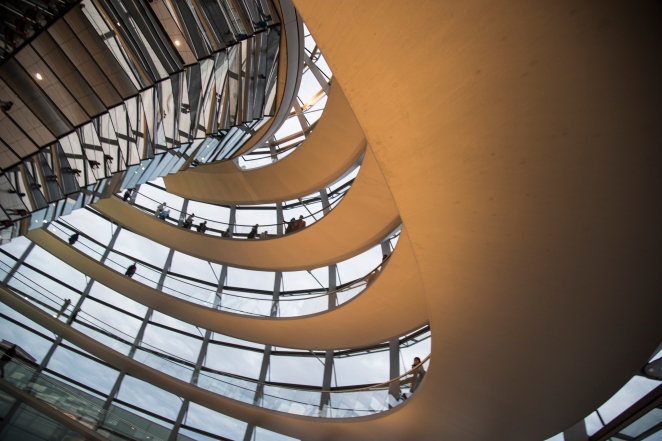




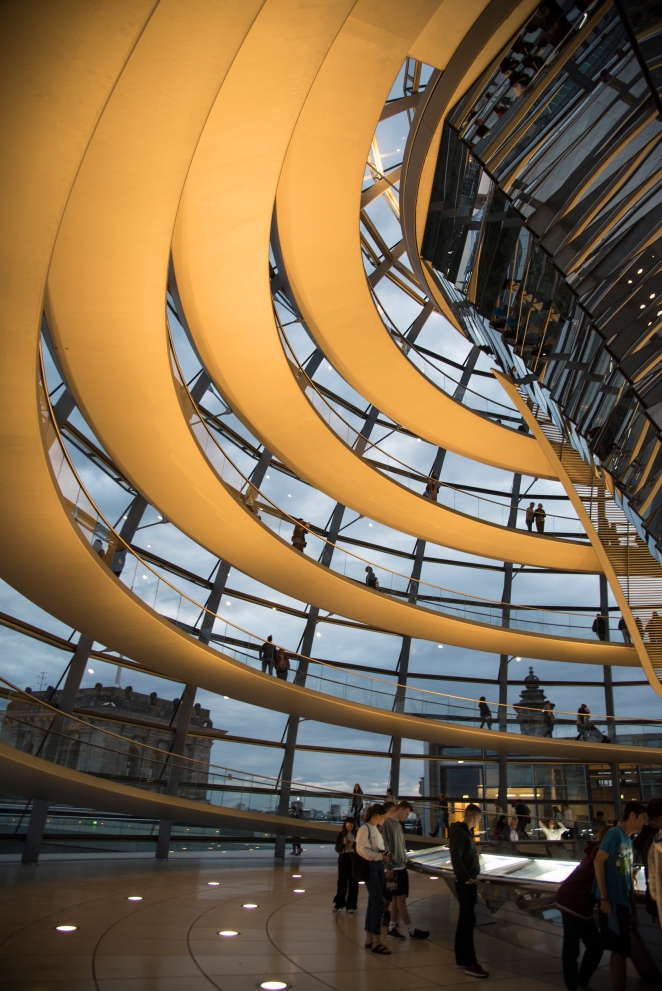
After the river boat excursion on the River Spree, we headed back to our hotel. As we drew near to the hotel, we came upon the Marienkirche, or St. Mary’s Church. The church’s website states “Presumably, the construction of the church as a parish church of the medieval New Town of Berlin was begun in 1270 . The first certain mention can be found in a letter of indulgence from 1294.”
I imagine that the three different exterior bricks are a testimony to the re-builds that happened during its history due to fire damage and then the upgrades that come about through time in response to stylistic preferences of each subsequent era.

As we approached we were struck by the contrasts between the ancient church and the modern television spire in the background.
The rough, hand-hewn quality of the exterior of the church did not prepare me for the elegance of the interior. Even with the scaffolding in place – old churches need lots of repairs – I was taken by the beauty and peace that pervaded the space.

The doors from afar.

This close-up of the doors shows the immense height in relation to the human form. A silent reminder to all who enter of who/what is really important?
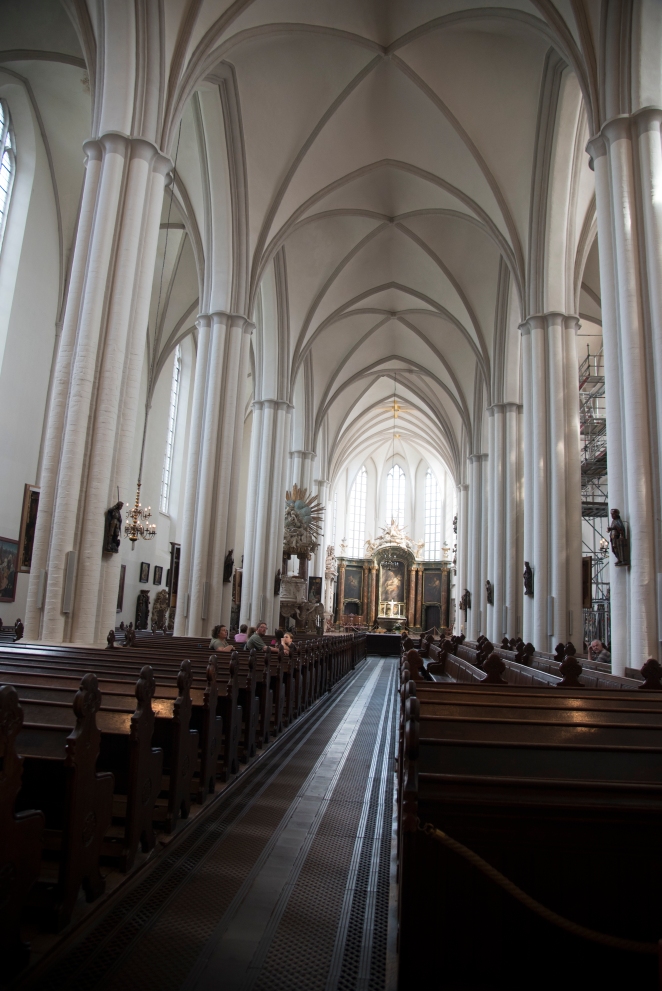
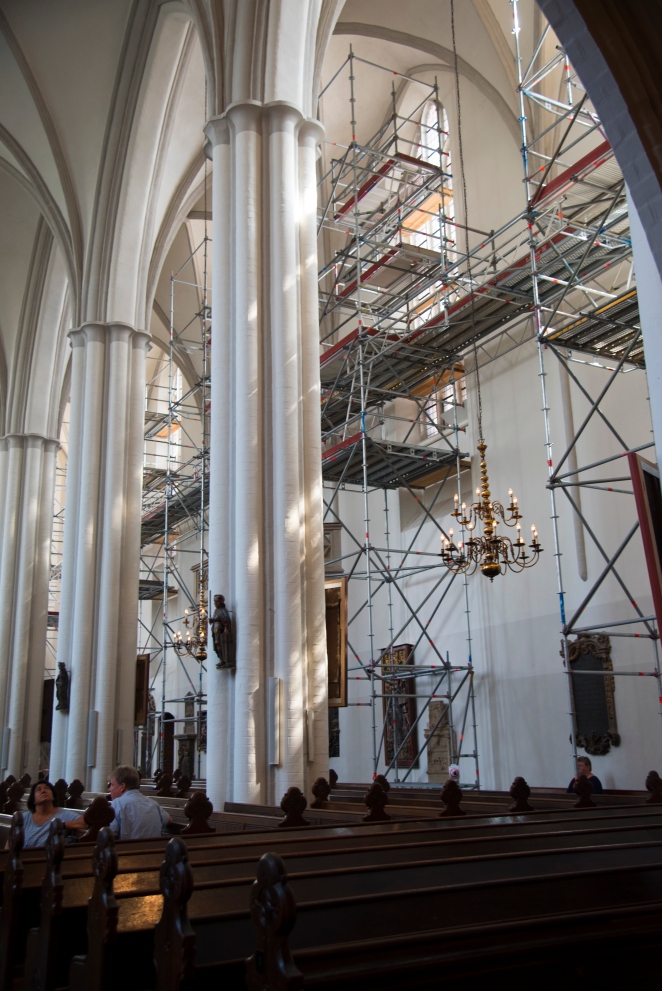
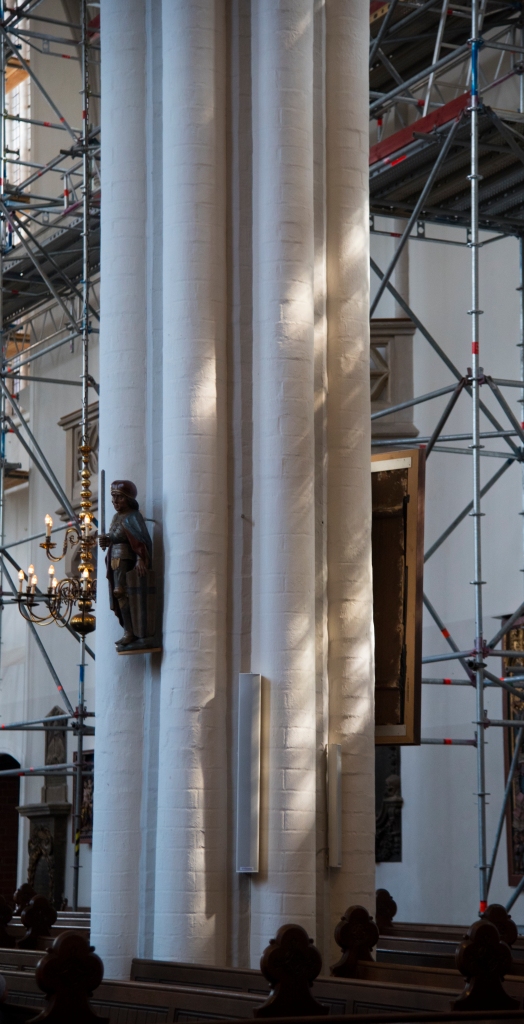
I love the movement of the light and shadow on the column.
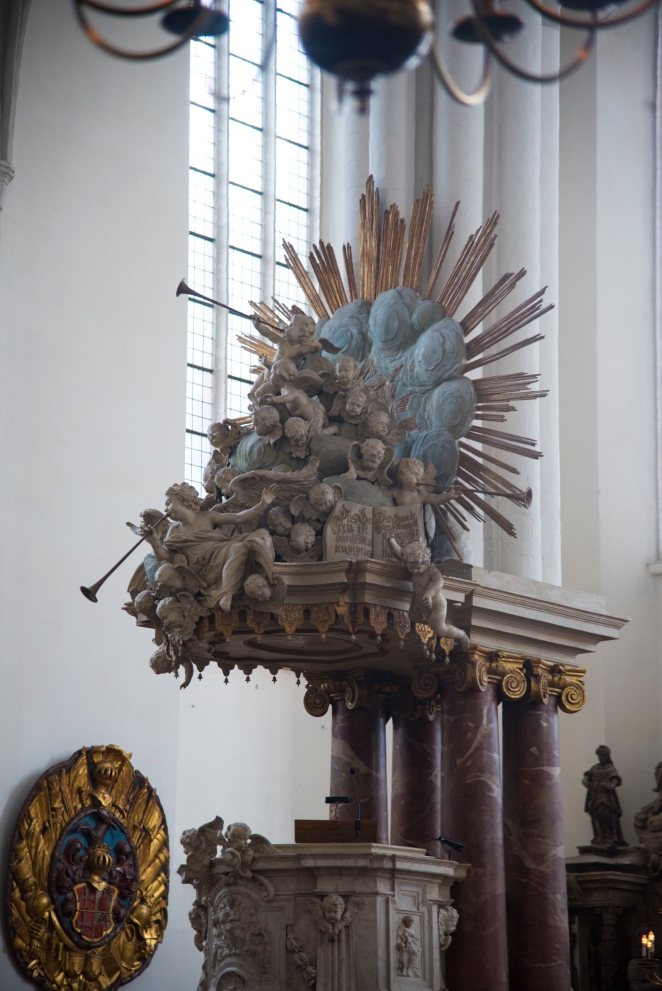
What a challenge it must be to proclaim scripture or sermonize when standing at this ambo.

The life in the faces and energy in their forms is so captivating!
Still jet lagged, but not wanting to miss precious opportunities to see Berlin, we set out on a walk to the river. After walking through an extended market along the curved street we looked down on last night, we finally hit on the river and walked in a westerly direction for about a mile before settling on a river cruise boat. Here a some shots from that lovely ride. 


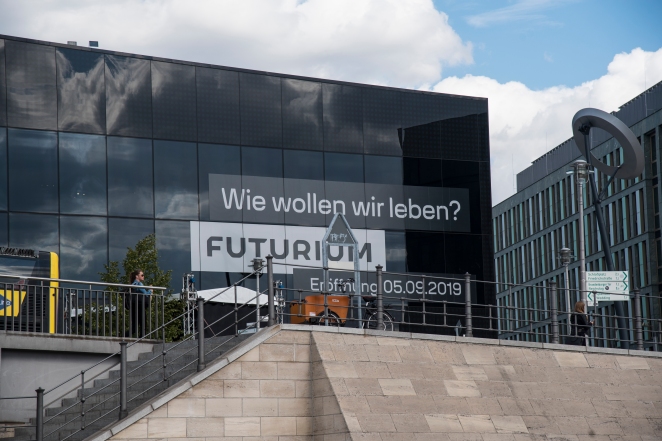

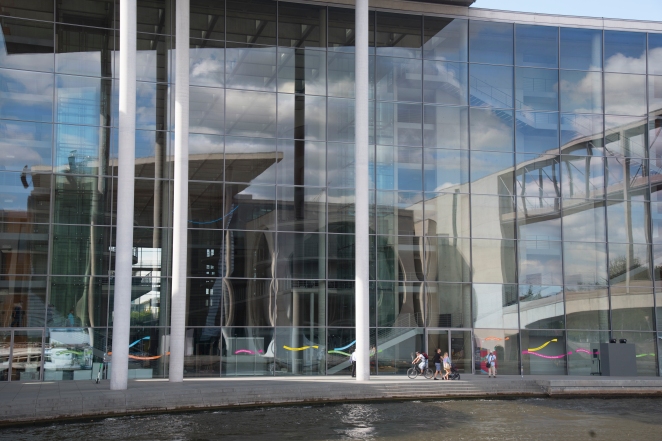



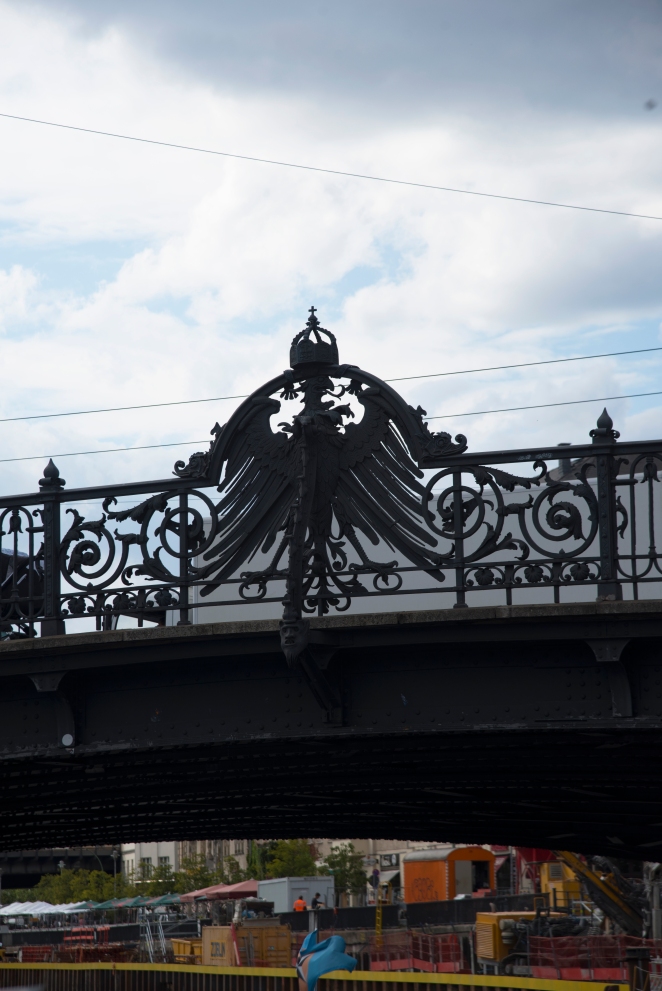








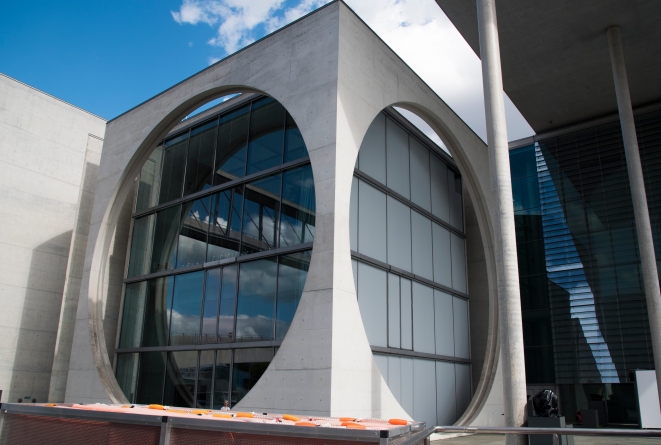

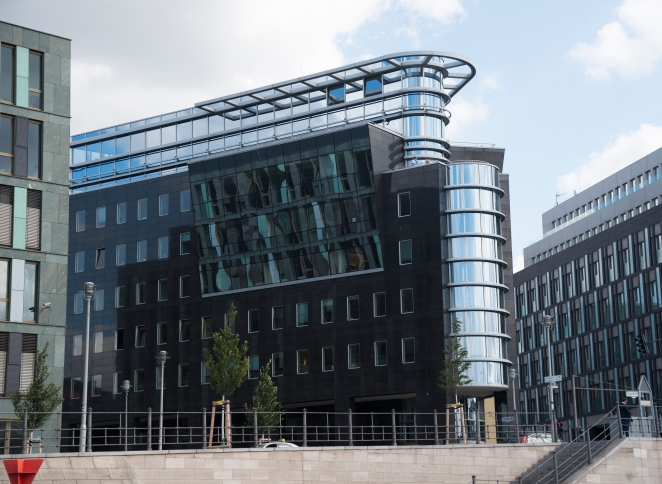




We arrived jet-lagged but juiced by the beautiful city of Berlin and the friendly welcome from all we met as we made our way across the city from TGL airport to our hotel the Park Inn Alexanderplatz. Here are a few photos from the roof-top observatory of the city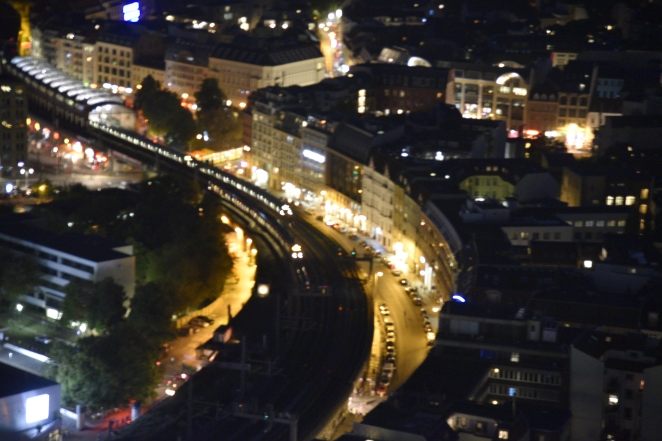

Welcome to the May 2019 calendar pages. This image was taken in Asheville, North Carolina a few years back when I began exploring a unique intentional community in that area. One of the properties that the community continues to consider how to rejuvenate includes a farm tract, trailer residences, and a large area where, in years past, folks have dumped old cars, thresher wheels, furniture, motorcycles, concrete mixers and more. A couple of tradesman had set up shop there too. In the midst of this polyglot of sights and possibilities was this very old, partially overgrown outhouse, and these whimsically placed chairs in a row on one side. I immediately imagined the chairs being there for those waiting in line to use the facility, and “Queuing for the Loo” became this image’s title. I was especially pleased to find a font for the calendar page that somehow echoes the feel of the old outhouse and aging chairs with peeling paint. 
This experimental film might also be referred to as a contemplative film. And it could just as easily be called a chance composition. My friend and fellow Goddard alum, Brenda Bowyer, conceived of a chance methodology for the creation of new art work, using special dice such as those used in Dungeons and Dragons. She asked me if I would like to play the chance game and I didn’t miss a beat in my “hell, yes!”
On March 3, I was given six weeks to make a work based on my unique results coming from the tossing of six dice. It will not surprise anyone who knows me that it took me eight weeks to complete the project. I stewed over possible ideas for seven and a half weeks and then had my aha moment this past weekend. All footage was gathered on Saturday and I finished the editing of the film, complete with credits this evening.
The film is 22 minutes long. I decided I didn’t want the criteria to create expectations in the viewer’s mind – I really wanted the viewer to have a “pure” experience of the film, so I wait until the end of the film to share with you the six elements that guided the creation of this work.
I will tell you one thing, though: I did a lot of research on non-narrative film for this project. what I learned became a primary driver for me in the creation of this work.
I welcome your feedback. Here is the link to RAIN
This image for the April page of my calendar was taken on the Campus of Goddard College in Plainfield Vermont on July 23, 2016. I had driven up through Michigan into Canada, stopping by to see fellow Goddard alum Annis Karpenko in Mississauga Canada. I continued driving a little further east before turning south to head toward Goddard for the commencement ceremony that included my friend Brenda Bowyer Farmwald. To make the event even sweeter, several of the Goddard alum from recent years were gathering at a beautiful farm house outside of town for several days. We intended to consider the ways that we might continue the meaningful activities of our joint studies while working toward our Interdisciplinary Arts MFA’s. We agreed that our group “hangs” on Google and the sharing of work and ideas while working in our diverse locations throughout the US, Canada and Europe was a rich and meaningful activity that we wanted to continue.
I saw this wire sculpture every residency. I presume (or heard?) that it was created by another alum of some years back. It had always interested me, but never more so than on this trip back to campus where I was keenly aware that I was no longer a student-insider, but someone slightly removed, off-center. I loved being back even as I mourned the loss of the focus and the rich interactions by and with faculty and fellow artists creating and implementing their study plans.
Having been raised in the Roman Catholic tradition, this tree form is richly symbolic for me. I was drawn to it, the smooth coiling wires of the trunk becoming gnarled branch and twig. In its bare form I perceived a living being manifesting a cycle of apparent deaths each winter and long-awaited resurrections each spring. No surprise that the power of this life-death symbology is leveraged in just about every spiritual and religious tradition throughout time.
Looking at the wire tree-figure that felt so alive to me, I experienced an ache, a yearning to be back again in the midst of the recurring cycle of our MFA residency. I wanted again to be immersed in each 15 week semester broken down into five three-week periods with “the packet” due at the end of each 3-week period. That had been my ruling cycle for 5 semesters. I still felt rootless without that cycle.
Rootless, like I felt leaving Columbia College after 12 years where our administrative lives were so closely tied to the academic calendar, with the grand climax each May with Manifest and three, then six graduation ceremonies over the course of two days – I helped plan them all. I attended them all.
Rootless, like I felt after 6 years at the Diocese of Gary in which the liturgical calendar rich with symbol and sacrament was the heartbeat of our work and prayer.
Rootless, like I felt when my marriage ended and I left the house in which the rhythms and schedules of kids’ lives, our work lives, our meal times, shower times, chore time and bed times were so inextricably woven for 22 years.
So many deaths and resurrections. Understanding the immanence here does not make easier the loss of each little world in which I have travelled for a while. Ironic, because I easily recall how I would chafe at the forms of each world with its cyclical demands, schedules and attendant frustrations. But once the form dissolved in the mist behind me as I walked away, how I missed those very things.
So. . . . the tree.
It still calls me to attention.

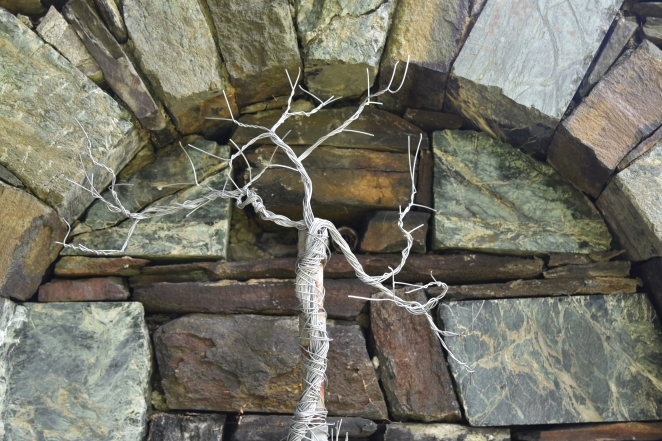

Jose Marti Memorial in Revolution Square (Plaza de Revolucion)
It’s been two months since I returned from my week in Cuba, traveling as part of the Hedwig Dances Touch Tour 2019 – the company’s fifth such curated immersion in the country’s art, dance, food, districts, monuments, history and more. There seems no simple way, no word or pithy phrase presents itself to me, to characterize my experience while there.
So, I begin with a few photographs from the first day and a few things my fellow travelers and I learned from our tour guide, Yunelbis. She would become a central figure during our week together, gently sharing information that enlarged our understanding even as she would offer us a different lens with which to view her country’s historical and political events, alongside Cuba’s vibrant arts culture, as well as the many dimensions of its current racial, agricultural, architectural and economic realities.
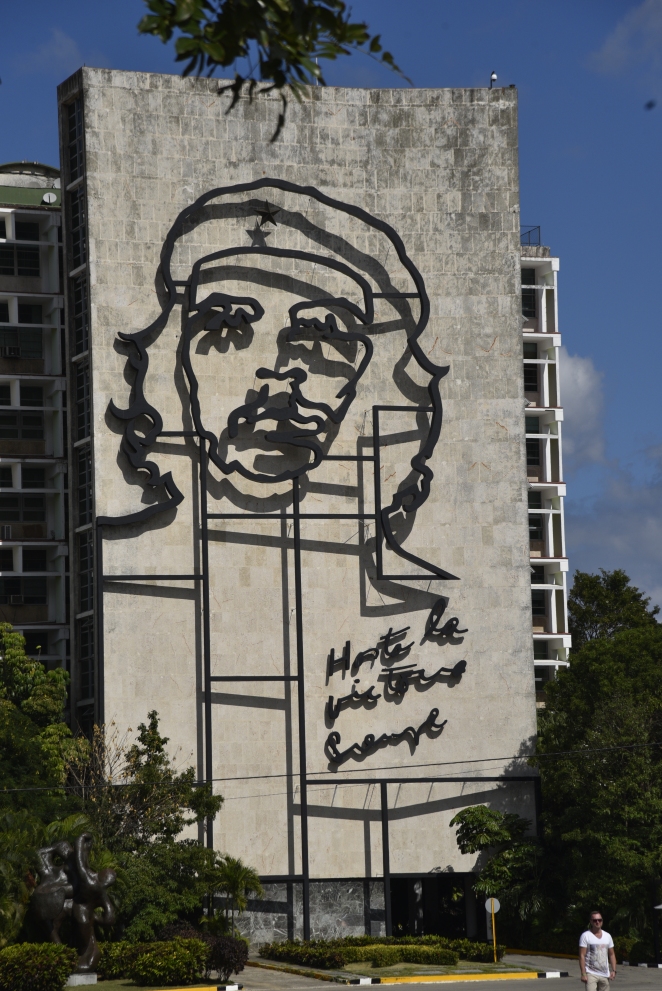
Che Guevara in Revolution Square, Cuba. “Hasta la victoria Siempre” or “Until the eternal victory”

Camilo Cienfuegos “Vas bien, Fidel” – “You do well, Fidel”
We noted that this location was well visited by many tour guides with their groups. We came to understand that the embargo has made tourism the most important means for Cuba to build its coffers, as long as the embargo prevents the export of any Cuban good to the USA.

This became a familiar site – the gathering of the travellers around Yunelbis, our guide, as she explained the significance of our surroundings even as she offered ways that we might navigate the terrain. How to tip, how to politely decline, how to negotiate a price, and so many more helpful insights. I was fascinated by our foot gear and our stances.

Light poles sans bulbs. So often I would see these giant forms, reminiscent of divining rods, that seemed to have no function. My guess is that they are light poles missing the bulbs – perhaps because of the ongoing shortages of parts of any and all kinds in the country, and perhaps because of the country’s seriously decaying power and water infrastructures.
On one side of Revolution Square was a large parking lot that was filled with the legendary Cuban taxis. These beautifully kept antique autos from the 50’s and 60’s were fascinating to behold. Yunelbis said that the many brilliant colors on the vehicles could be traced back to another reality of the strapped economy: Discontinued auto paints would be purchased in lots for reduced prices and then, once in the country, the word went out and the paints were snapped up by those wanting to spruce up their old automobiles. The embargo is the underlying cause that no new automobiles can come into the country – no one can afford them. The embargo makes everything that comes into the country very expensive because the ships that come in laden with goods must go out empty – hence the return trip is major lost revenue. To make up for the loss, the ships charge more to the importers, who make up that additional cost by charging more for the goods being shipped in.


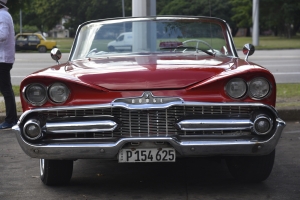
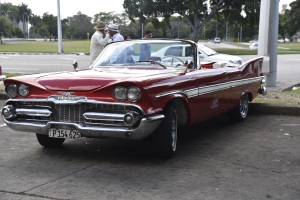


Melia Cohiba 17th Floor Lounge daily offerings for weary guests
The group had been traveling by shuttles, busses, and planes for the better part of two days to get to this point on Day One in Cuba. My roommate Marcia and I had caught the 7:30 am shuttle from our Miami hotel to get to the airport with enough time to go through customs and then catch our flight to Cuba with the rest of our group. After our extended walk-around of Revolution Square we re-boarded our bus, travelled across town, and then gratefully arrived at Melia Cohiba to check in, have a snack, accompanied by our first of many welcome Mojitos, refresh and then off to our first dinner in our first paladar.
“Paladares are a uniquely Cuban phenomenon,” said my tour packet. After the revolution and the mass exodus of so many people and the resultant economic crash, these private enterprises became an increasingly popular way for people to earn a few extra dollars by turning their homes into restaurants. We were also advised that all payments to the restaurants are in CUCs, (Cuban Units of Currency that are used exclusively by tourists to the country), which are then turned into the government along with earnings reports, from which the government takes a percentage and converts the CUCs into Cuban pesos, the local currency used by the citizenry. That evening, Atelier would offer us our first experience of this uniquely Cuban phenomenon.

Walking into the foyer on the ground floor, we see the staircase to the second level where our meal will be served. Marilyn, Marcia and Maray lead the way, while Melinda and Daniel stand on the threshold.
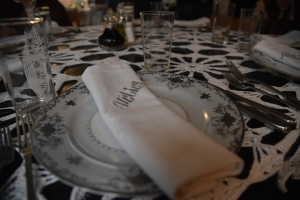
The antique china and silver, the embroidered linen napkins and the crocheted open-work table cloth signaled to us that every detail of our meal would be thoughtfully attended to.
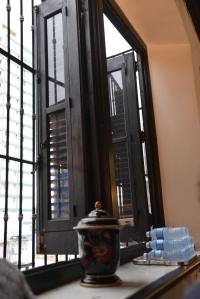


At dinner that evening we each stood in turn to introduce ourselves to the others in the group. We were sixteen members in all; many from Chicago, one from Omaha, one from New York City, one from upstate New York, one from Washington DC, and one from California. We began to bond that night and through the rest of the trip we experienced an enriching sense of connection, delight in shared discoveries, and growing mutual appreciation. We arrived at Atelier when the light was still strong. When we left it was dark. After returning to our hotel, which overlooks the Malecon, a small group of us decided to brave the 4-lane highway to get to the ocean side.

The Malecon.
Look for more entries in the upcoming days and weeks on my experiences on this trip. I hope to understand better as I share the images and write about the days, the people and the discoveries.
The image for March was taken in the Hartford Reservoir in Connecticut in February or March of 2002. Not too sure on the date at this point. I was visiting my daughter Kara, who lived on the 3rd floor of an old Victorian home in the historic district of Hartford. She was working at the Hartford Stage at the time. While Kara was working I went for a hike in the reservoir – the light was my favorite kind of light that comes in late winter with overcast skies and much moisture in the air. I came across an old stairwell that still stood, covered in moss, though whatever structure it once led to was long gone and no trace of a building foundation remained to tell its story.


WayMaking Artist’s 2019 Calendar by JulieV
2018 was the inaugural year for my limited edition calendar featuring photographs I have taken while in a state of mindful awareness, a state of being and creating that I eventually came to refer to as my contemplative photography practice. More about that practice in paragraph 3 below.
Making the Calendar this year and last year: As a creative act in and of itself, selecting the images, assigning each to a specific month in the year and the design of the accompanying calendar page was so satisfying for me that I felt compelled to repeat the process for a 2019 calendar. In 2018 I accompanied the images with poetic prose and poetry that felt somehow resonant with spiritual elements in the photographs. In 2019 the images are presented wordlessly in my attempt to discover if they indeed are ‘worth a thousand words.’ Your feedback is welcome. AND, I have a few more calendars left in the original run of 100 – they begin with February 2019 and end with January 2020. Email me if you’re interested in purchasing one: julia.m.volkmann@gmail.com — $10 per calendar plus $2.50 to ship. Tell me your birthdate and I’ll personalize it for you.
About my practice: Even before I found a way to label this practice (or should I say “characterize” this practice?), I had been explaining to the unfortunate souls who had to suffer my long philosophical ramblings on the subject that the act of taking the pictures afforded me an opportunity to be still and be totally immersed in the contemplation of the object or scene in situ; the quality of the light, the touch of air on my skin, the sounds of the place and the sense of being both observer and subject in the image, even if I was not seen in the viewfinder. My experience of capturing the image was actually an act of paying deep attention, which elicited in me a stillness, a focus, an awareness of the breath that everyday noise and bustle of life could never permit.
During my MFA IA studies at Goddard College in Vermont, my photographic practice was awakened again after lying dormant for some years. When I submitted a series of my photographs as part of my portfolio work for that semester, it became necessary to research this “thing” I was doing so that I could speak of this art practice in relationship to others’ work in the world – how it might be similar, where it differed, etc. I was gratified to find Stephen Batchelor’s essay “Seeing the Light – Photography as Buddhist Practice” in Buddha Mind in Contemporary Art, edited by Mary Jane Jacob and Jacquelynn Baas (University of California Press, 2004). I saw how Batchelor and I were aligned in our approach and experience, even though the work we produced was not at all similar. Having read his essay, I was able to lay claim to the term “contemplative photography” as the way to refer to my practice.
About the cover image: I took this picture on my way back home from Goddard College summer session in August 2014. I had stopped at a local motel for the night. The next morning this motorcycle was in the space next to mine. I was stopped dead in my tracks by the message and had to dig out my camera to take the picture before I went across the way to get my free coffee and continental breakfast (i.e. dry sweet roll) prior to continuing my drive home. When I feel most aimless or hopeless or clueless about whatever road I have found myself on – be it spiritual, metaphysical or literal I try to remind myself of the value of exploring. The straightest distance between two points is not A way, or the ONLY way, or the best way, to get where you’re going. Life happens on the journey.